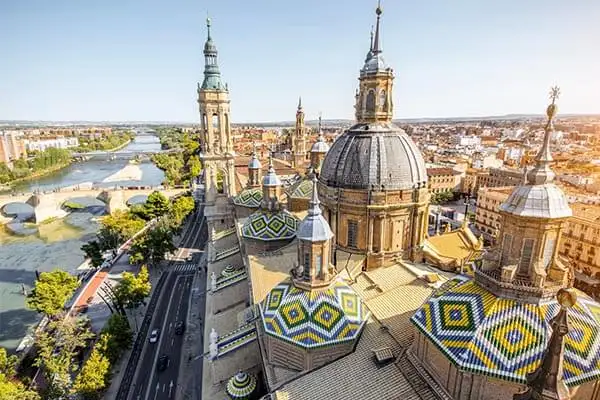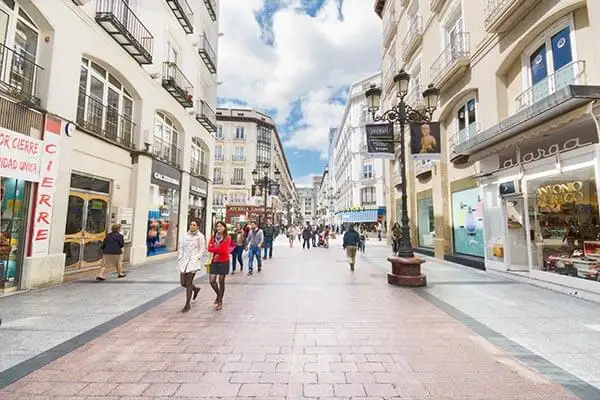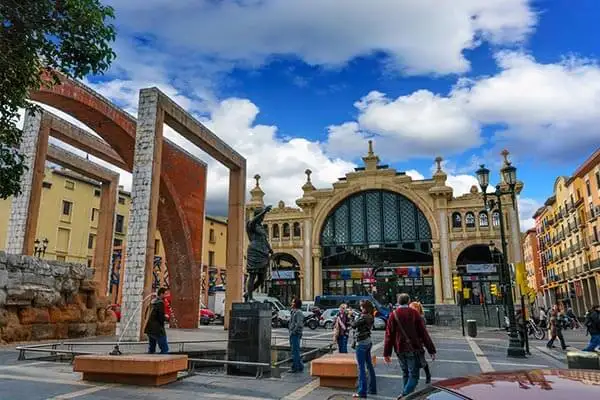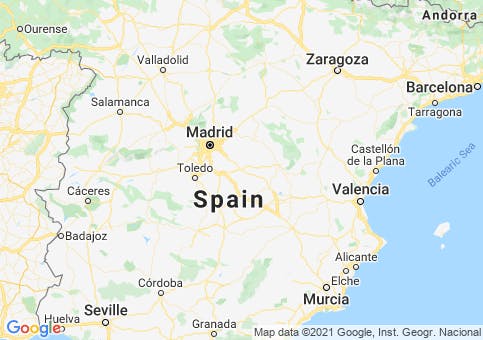Stunning landmarks, famous folklore, and traditional gastronomy are only a few things that make Zaragoza a small city worth visiting and considering living in. The magical land is set in Spain’s northeast, and Zaragoza is the capital of the Aragon region. The area is one of Spain’s most overlooked and underrated regions. Stretching from the Valencia region in the south to the Pyrenees Mountains to the north, it is filled with national parks, mountains, historic castles, stunning architecture, and Romanesque churches throughout many medieval towns.
The city of Zaragoza, also known as Saragossa in English, first became a settlement by the Iberians in the 5th century BC. Spain’s fifth-largest city rests along the River Ebro. With more than two thousand years of history and one of Spain’s previous kingdoms, it offers some of the greatest artistic and historical legacies in Spain. Archeological remains are a reminder of the grandeur of the city during the Roman Empire era with many public buildings showcasing the influence of its founder, Caesar Augustus.

It is unknown why tourists and people considering a move to Spain often overlook the city of almost a million people. The city center is home to a shrine of the Virgin Mary within the Baroque Nuestra Señora del Pilar, the multi-domed Basilica. Some say that it is the oldest shrine in the world dedicated to her. The Basilica is located along a famous pilgrimage site that is actively debated to be the most or second most popular pilgrimage site in Spain. The debate is between Zaragoza and Santiago de Compostela.
Zaragoza is also home to the 11th-century Aljaferia, a Moorish Palace built during the Muslim occupation of Spain. Gothic and Islamic architecture are sprinkled throughout the center. The 12th-century Cathedral of the Savior is also worth visiting as it, along with other Mudéjar-style landmarks, is part of the UNESCO World Heritage Sites.
The strategic location of the growing city makes it an ideal place for those that enjoy visiting larger cities and beach towns but don’t want to live in them. Zaragoza is located halfway between Barcelona to the east and Madrid to the southwest. You can drive to either city in three hours. Alternatively, there are several buses and trains you can take, bringing you right into the city center if you don’t want to drive. From Zaragoza, you can easily reach the Pyrenees Mountains or drive to the small country of Andorra in about three-and-a-half hours.
Get Your Free Spain Report Today!
Get Your Free Spain Report Today!
Learn more about the lower cost of living in Spain and other countries in our free daily postcard e-letter. Simply enter your email address below and we'll also send you a FREE REPORT — Live the Good Life in Sunny, Affordable Spain.

By submitting your email address, you will receive a free subscription to IL Postcards, Overseas Dream Home, The Untourist Daily and special offers from International Living and our affiliates. You can unsubscribe at any time, and we encourage you to read more about our Privacy Policy.
Retire in Zaragoza

The retirement process in Spain is generally straightforward. However, it can be a little time consuming, so you will need to have some patience with it. There are several visa options available. You will need to find the one that suits you best, get all the paperwork together and file for the visa. Once you have your visa, the fun begins and your new life in Spain will start. Of course, things are a little easier if you are moving with your spouse or significant other; however, many single people move to Spain as well.
Before you move to Spain, you should have a basic knowledge of Spanish. Castilian Spanish is the official language in Spain; however, German, French, and English should be understood in most hotels and tourist areas. In The surrounding areas you will hear Galician, Catalan, and Basque spoken. Smaller cities and towns throughout Spain may not have any English-speaking people. There are several Spanish schools throughout the city to help you learn and improve your Spanish skills.
Meeting friends is going to be another task that needs to be high on your priority list. No matter where you live, you won’t be happy if you don’t make friends. You can join the English Speakers in Zaragoza Facebook group to start getting to know what is going on in the city. Internations.org and Meetup.com are both excellent platforms to use to find activities with like-minded people. Not only will you be meeting new people, you will also be enjoying some activities you already like or discovering some new ones.
Healthcare in Zaragoza is similar to healthcare throughout Spain. For your visa application and the first year in Spain, you will need to have private healthcare insurance. After this time, you can apply for the Spanish National Healthcare Service. Once approved, you can decide if you want to continue with your private insurance or cancel it. Universal healthcare in Spain is publicly funded and free to use. There are five main hospitals in Zaragoza in addition to several public and private healthcare centers.
Traveling to other cities and towns throughout Spain and neighboring Portugal, Andorra, and France are very easy. If you’re like me and don’t want to have to buy a car, you can still easily travel here. You can take a train or bus to countless destinations. Here are just a few examples for you from The Train Line website.
The average journey from Zaragoza to Madrid or Barcelona takes about one hour and 45 minutes per leg. The cost can range from 15 euros to over 100 euros, depending on the time of year, the time of day, and how early your ticket has been booked in advance. Trains do sell out, so it is advisable to purchase online in advance through websites like Renfe.com, Thetrainline.com, or RailEurope.com.
Best Neighborhoods to Live in Zaragoza
By Maria DiCicco
Casco Historico (Historic Center)
At the center of everything, the Casco Historico (Historic Center) features walkable lanes, hundreds of tapas, bars, and restaurants, most of the city's attractions, and historic real estate.
For expats and visitors looking for a central location, the Casco Historico offers numerous public transportation options, including access to the light rail running north to south, grandiose promenades, picturesque plazas, and an ideal walkability score to everything one may need.
Barrios like Plaza de Los Sitios target the younger upscale crowd, while La Magdalena offers more sprawling real estate options along the Rio Ebro area.
Following the vein called Calle Coso, quiet and narrow alleys can be found full of charming options for real estate as well. Finding the right plaza to live near is an important part of the selection process in Zaragoza, as each plaza features something unique. For instance, Plaza de Los Sitios features green spaces and a nice playground for kids. Plaza Santa Marta is a popular area for tapas, so activity is only steps away, but the noise from the street will come with it. The aforementioned Calle Coso is a prime spot for daily living, but during city festivals like the Fiestas del Pilar or even at Easter, when parades of people march down the lanes, expect to be met with heavy foot traffic.
In other words, the historic center is a hotbed of life, so expect to open apartment shutters to the sounds of neighbors’ music, laughter from the streets, and, yes, the occasional event parading past.
Consider also that in the historic district, many of the older buildings cannot accommodate an elevator, so prepare to walk up stairs. In Spain, there is a floor zero and sometimes an intermediate floor between zero and one, so living on the first floor could mean you are still walking up three flights of stairs.
It is good for those in good physical health and for those looking to be in the center of the city. The historic center is easy to get to by train or by the regional airport and offers an authentic place to experience Spain without the changes tourism booms can bring.
Rentals cost $650-850 per month with one and two-bedroom apartments ranging from $140K-250K.
Actur
This charming area of town just north of the Historic Center is buzzing with modernity. With newer builds from the later part of the 20th century, visitors and expats will find a plethora of convenient shops, cafes, and the Gran Casa mall. Actur has several stops on the light rail line, connecting south-central Zaragoza to Actur and beyond, making commutes to any of the neighborhoods very easy.
With the large Carrefour steps away, and the Gran Casa mall’s modern shops, Actur is a shopper’s paradise.
Nearby, stroll to the river banks and the city aquarium, or choose from one of many wonderful Asadors (steakhouses) and restaurants to eat in.
This area is great for families looking to settle somewhere modern, clean, and convenient.
Expect a one—or two-bedroom apartment to cost around $160K-$225K, with rentals averaging $650-900 per month.
Distrito Universidad
Roughly the area surrounding the majestic Parque Grande and La Romareda stadium, this area is full of mid century apartment buildings. With close proximity to wonderful schools and hospitals, this section of town is well situated for younger families and old alike.
Although dining options and shops are fewer in this neighborhood, expect to find a favorite cafeteria or bakery within steps, and commute for the other conveniences. At La Romareda, find a hub for futbol fans, including bars and cafeterias, and of course the stadium to catch a game.
Parque Grande is fantastic for a stroll through green spaces and offers many fountains, alcoves to read a book under a tree, and multiple playgrounds for children of different ages. The park also features several seasonal outdoor restaurants and pathways to explore.
With the light rail bisecting the neighborhood for miles, any choice of accommodations along this stretch provides convenience to the rest of the city. Or, choose to walk the Gran Via, the long stretch of pedestrian green space flanking the light rail tracks. The Gran Via leads directly to Plaza España, the busy epicenter of the Casco Historico.
Great for quieter and more affordable living, this neighborhood is an excellent option for living in Zaragoza, with convenient commutes to the heart of it all.
One—or two-bedroom apartments range from $120K to $190K, with rentals from $650-850 per month.
Torres San Lamberto
Again convenient to a Carrefour (with a secret outlet inside!) and a mall that has frankly seen better days, the San Lamberto area is a great choice for those who want to be close to the train station. With buildings only 3 or 4 stories tall, city living feels more approachable for those who need to see more skyline. Finding a home with a yard and parking area can be achieved here, making the suburban neighborhood even more comfortable. It is also a nice place for anyone with a dog, as there are sidewalks and green spaces for them to enjoy a stroll.
Great for families with a vehicle, the San Lamberto neighborhood also offers a little more space to spread out, including larger apartments and porch spaces for a BBQ or afternoon cocktail.
Rentals are fewer here but range from $575-750 per month, with one and two-bedroom home purchases from $275K-500K.
Venice Park
Quite possibly one of the newest developments Zaragoza has seen in the 21st century, this area near popular shopping mecca Puerto Venicia is an excellent place to settle outside of town. It’s paramount to have a car here, unless you enjoy navigating the bus system, which is quite easy and comfortable to ride.
There are many fast-food restaurants and typical American chains like Popeyes and Taco Bell, and the Puerto Venicia mall area has everything from IKEA to hardware warehouses and, of course, modern mall shops like H&M and more.
This area is fantastic for creature comforts but only features high-rise apartment buildings. The space is largely still dusty desert land, so it is possible that more will be built out in the future.
Average home prices range between $200K-300K, with rentals available from $830-1500 per month.
Areas to Avoid in Zaragoza
By Maria DiCicco
Plaza de Toros/Calle Ramon Pignatelli
As advised by real estate agents we dealt with, there is really only one place to avoid when searching for places to live in the Casco Historico. This area is along a stretch of road called Calle Ramon Pignatelli, leading towards the historic Plaza de Toros. Just west of the Mercado Central and very close to the Roman Walls and Plaza del Pilar, this area has a surprising amount of underbelly activity worth noting.
By day, this area is perfectly fine, and the homes can be stately and opulent. Unfortunately, there is a problem in this area that is seeing reform for the better, but still remains. The area brings in gun shops, sex shops, prostitution, and for the home owner a big scare - squatters. Once the squatters move in, the government has a hard time helping to remove them.
The area once was a place of drug crimes, including shootings, but this was decades ago. As it attempts to renew itself, this area will have several lovely homes available on the marketplace at an unbelievable price. It is advisable to take heed of a deal “too good to be true” if it is in this area, and perhaps look elsewhere as they continue to reform.
Things to Do in Zaragoza, Spain

This underrated city in Spain has numerous things for tourists and locals to do. The city is full of museums and historical architecture ranging from the old Moorish fortresses and Roman Theatres to updated markets and new art galleries. Here are a few places you must visit in Zaragoza.
Basílica de Nuestra Señora del Pilar
The Pilar Basilica, for short, is one of the vital Marian sanctuaries in the Catholic realm. It is believed that the Virgin Mary appeared here on January 2nd, 40 AD, and left the pillar behind. Over the centuries, chapels and churches were built surrounding the area leading to the grand Basilica being constructed.
Catedral del Salvador de Zaragoza
The Catedral del Salvador de Zaragoza is also called La Seo. It includes many elements from Baroque, Gothic, Mudejar, Neoclassic, and Renaissance times. It is believed that an original mosque was built sometime before 718 in the same location. Then the Romanesque cathedral began construction in 1140. Followed by The Gothic-Mudéjar Cathedral (1318), Renaissance (1403), and many years of de-construction and re-construction ending with the most recent restoration being completed in 1998. It is part of the World Heritage Site Mudéjar Architecture of Aragon.
Palacio de la Aljafería
The fortified medieval Islamic palace dates back to the 11th-century when the area was under Abu Jaffar Al-Muqtadir rule. The palace was then home to the Banu Hud dynasty. It is considered one of the artistic jewels of the Muslim presence in southern Europe and is the current seat of the Aragonese government today.
Zaragoza Central Market
Mercado Central first opened in 1903. The grand space of archways and columns is filled with stalls selling everything from fruit and vegetables to meat and seafood. You can also purchase a variety of baked goods, olive oils, and cheese. It is the perfect place to pick up groceries for the week or to prepare for a picnic in the park. The center stalls now also provide areas to sit and relax with a montadito or some tapas and a cold drink.
Puente de Piedra
Puente de Piedra, or stone bridge, is one of the most recognized features of Zaragoza. Initially, a wood bridge was built here back in Roman times. The one you see now was built in the 15th century and has had many updates over the past centuries.
Sala de Exposiciones La Lonja
Currently used as Zaragoza’s most prestigious exhibition space, La Lonja was built between 1541 and 1551. Influenced by Mudéjar and Florentine architecture, it is a superior example of the Renaissance style within the city.
Zaragoza’s Roman Ruins
Discovered by accident, many road expansion or parking structure projects yielded incredible finds - ruins of ancient Roman-ruled Zaragoza. Founded by Caesar Augustus, the city was once walled in along the river and was an active port for the Romans. Today, find a well-preserved Roman Amphitheater, the old forum underground, the thermal baths, remnants of the old Roman walls, and more. One ticket gets visitors in to see all the Roman sites in town.
Aquarium of Zaragoza
The impressive aquarium in Zaragoza is said to be the largest freshwater aquarium in Europe. Explore the many exhibits, including those with species from the Amazon, crocodiles, piranhas, and massive prehistoric fish.
El Rastro Flea Market
Held every Wednesday and Sunday near the Delicias train station, the Rastro flea market is primarily a market for the locals, meaning good bargains. There, shoppers can find housewares, dresses and blouses, second-hand clothing, tablecloths and linens, handbags, jewelry, sunglasses, and more. Neighboring the modern market on the same lot, rows of antiques, from knickknacks to furniture, are for sale. A small farmer’s market is also found on-site for purchasing fresh produce.
Pedestrian Shopping Streets
The primary arteries in Zaragoza provide pedestrian-friendly passageways for shoppers and restaurant-goers alike. The Gran Via follows the light rail line, where upmarket modern stores can be found. Along the Calle Alfonso, walk the pilgrimage path towards Plaza del Pilar, finding jewelry and souvenir shops along the way. Finally, Calle Don Jaime is full of clothing stores, shoe stores, and several souvenir shops for visitors.
Parque Grande
Parque Grande is an elaborate and large green space in the center of the city. Featuring playgrounds, bike paths, restaurants, and fountains, strolling the park is one of the many joys of visiting Zaragoza. The main staircase to the upper gardens looks like something from an Italian villa, providing beautiful vistas great for photo taking.
La Romareda Stadium
The local futbol (soccer) team is called Real Zaragoza, and La Romareda is their home base. In season, you can buy futbol game tickets online in advance and experience the joy and revelry that is game day in Spain.
Goya Museum
The infamous painter from nearby Fuendetodos spent many years of his life living and working in Zaragoza. The Goya Museum pays homage to Francisco de Goya and his many varied works of art. From his early portraits to his cartoonistic and political etchings, the museum provides a number of his original works, as well as a gallery of artists inspired by him.
Is it Safe to Live in Zaragoza?
By Maria DiCicco
Spain, in general, is very safe, with proper considerations made for petty theft, pickpocketing, and crime relating to prostitution and nightlife. In Zaragoza, however, the crime rate is practically unheard of. In Zaragoza, it is common to see entire families, including young children, out until midnight strolling the streets after a late-night meal. As in all places, late bar nights can lend to late-night wanderings of drunkards, but aside from hollering loudly, these creatures of the night are harmless. In fact, walking at night in most areas is perfectly safe. Women are not gawked at or catcalled, and in all truth, are mostly ignored for their walks home. Because of the abundance of young and old strolling the streets at night, it is no different than in the daytime and is very safe.
There are some areas to be avoided in the evenings, however, namely near Calle Ramon Pignatelli and the Plaza de Toros area, where the nightwalkers are of a different influence, often participating in minor drug crimes and prostitution.
Zaragoza is a wholly walkable city, so at any given time of night, even into the wee morning hours, no one will find themselves alone on a street. That said, take the typical precautions—carry cross-body handbags, leave valuables at home, and avoid wearing ostentatious jewelry. Men can carry wallets without worry, although “man bags” are quite common in Spain and a great way to secure belongings.
During the day, it is common to see Africans peddling knockoff purses, jerseys, and shoes. As a patron of their services, it is okay to browse and shop for their goods but be aware that it is not technically legal. The government tends to look the other way, but in some cases, they have been chased off. In this case, be conscious of your surroundings so as not to get knocked over unaware.
Buses, trains, and public transportation are clean, affordable, and effective ways to traverse the city. Unlike subways and public transport in larger cities, these modes of transportation are seen as exceedingly safe and accommodating. Families, children, teens, and the elderly all take public transportation without issue.
Graffiti is commonly seen across Zaragoza, but it does not indicate an area’s safety. In fact, much of the historic center’s famous tapas lanes at El Tubo are covered in street art, creating a hip scene for visitors.
Zaragoza is a decidedly family-friendly city, and while awareness of crime is always advised, it is not something to be concerned about.
Day Trips From Zaragoza
By Maria DiCicco
Wine Country
In a nation where every oenophile has heard of Rioja, Zaragoza hardly makes a splash on the wine country radar outside of Spain, but it should. Surrounded by more than five high profile wine growing regions, day trips to wine country are easily within an hour or two of the Aragonese city.
Many of the wine regions can be reached by train, including Cariñena, Calatayud, and Tudela, but wine country is best explored by car to experience the vineyards of Campo de Borja, Navarra, Somontano, and Logroño’s Rioja region.
It is advisable to research wineries using Google Maps in advance and contact the wineries directly or through their web forms to reserve a tour and tasting. Typically, unlike wine tasting in the United States, a bodega (winery) offers one tasting per day, which will include a tour of the facility and often some Aragonese snacks like cheese or jamon. Book several days in advance, if possible.
Belchite
A whisper of Spain’s deadly past, the ghost town of Belchite holds the ruins and remnants of an entire village devastated by attacks during the Spanish Civil War in the late 1930s. With tours operated in Spanish (with audio guides in many other languages), visitors can experience strolling through the quiet village, and learning of its history.
Sign up for the duo ticket online. Next door to the ruins, visitors can find a historic olive oil mill, still in operation today. The mill conducts tours and tastings for tourists and offers many wonderful products in its shop.
Lastly, the town of modern Belchite has several nice restaurants to choose from after the tours, so plan accordingly for a large lunch before returning to Zaragoza.
Olite
The small village of Olite, only 1.5 hours north of Zaragoza on the road to Pamplona, is home to not only wineries and a historic parador, among other beautiful landmarks, but it is home to a quintessentially cute fairy tale castle. Spend an hour or two exploring every parapet and turret, then enjoy a long and lingering Asador (steakhouse) lunch in the quaint town.
Monasterio de Veruela
At the base of Zaragoza’s nearest mountain range of Moncayo, find wineries and restaurants for long lunches among the quiet roads where the Monasterio de Veruela humbly sits today. The beautiful monastery has been featured in numerous Spanish films and television and is a beautifully preserved piece of Spanish history.
Monasterio de Piedra
Near Calatayud, a winding mountain road works its way past wineries and stunning vistas before emerging upon a large parking lot at the Monasterio de Piedra. Hikers, guests seeking cool weather and overnight stays in luxurious lodging, or families looking for a few hours in the outdoors will all enjoy a visit here. Not only does the monastery offer exceptional ruins of a beautiful religious time capsule, but the main draw here is the footpaths in the surrounding grounds. Featuring waterfalls, caves, and massive gorges, serenity is easy to find. Paired with a meal at one of their two onsite restaurants, or with an overnight stay in the old monastery housing, this destination can be part of a day trip or a longer venture.
Other Day Trips
Venturing north from Zaragoza, visitors can find countless day trips to places like Loarre Castle, Huesca, and Alquezar. They can also take a drive into the Pyrenees mountains or head further northwest to Basque cities like San Sebastian, Hondaribbia, or Bilbao. Daroca and Albaraccin are incredibly beautiful villages in Zaragoza’s southern reaches, and of course, day trips can be conducted by train to Madrid, Barcelona, or beyond as well.
Whether you are considering moving to Zaragoza or just going to enjoy the fascinating history and architecture, you won’t be disappointed with the time you spend in this city.
Get Your Free Spain Report Today!
Get Your Free Spain Report Today!
Learn more about the lower cost of living in Spain and other countries in our free daily postcard e-letter. Simply enter your email address below and we'll also send you a FREE REPORT — Live the Good Life in Sunny, Affordable Spain.

By submitting your email address, you will receive a free subscription to IL Postcards, Overseas Dream Home, The Untourist Daily and special offers from International Living and our affiliates. You can unsubscribe at any time, and we encourage you to read more about our Privacy Policy.















